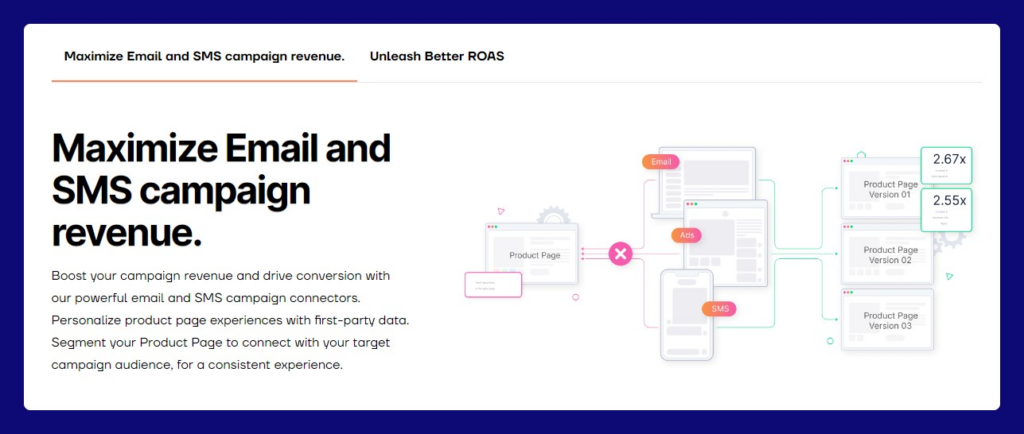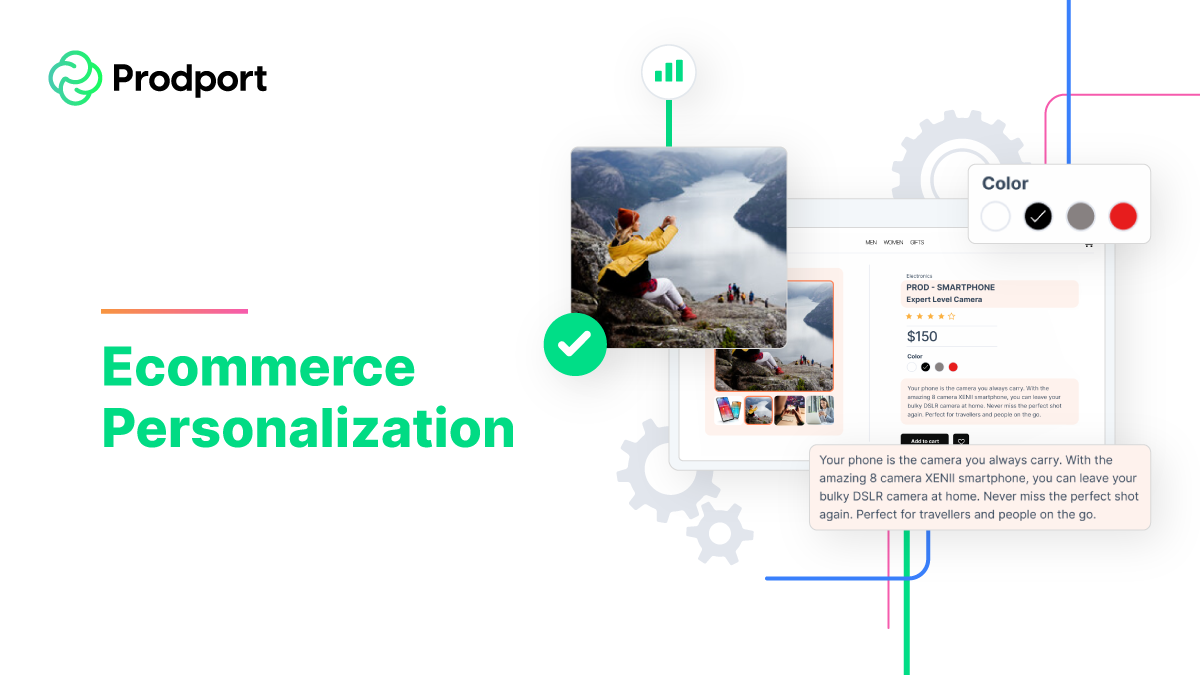As these days, offering a one-size-fits-all shopping experience is no longer sufficient, you can’t afford to treat all customers the same – whether newcomers or loyal ones.
Today, each user of your online store expects a customized experience that satisfies their specific needs and desires.
And that’s where ecommerce personalization comes in.
But what is it? Why is it important? What are the benefits of personalization in ecommerce? And finally – what are the tactics and best practices you can follow?
All answers are here. ⬇️
What is ecommerce personalization?
Ecommerce personalization is the practice of tailoring the online shopping experience to individual customers. It leverages customer preferences and behaviors and ultimately benefits both recipients and businesses.
Ecommerce personalization strategies utilize data and insights to deliver relevant content, product recommendations, and offers.
Thanks to such personalized content, you can streamline the customer journey and increase customer satisfaction.
The importance of ecommerce personalization
We just mentioned that applying a one-size-fits-all approach to all visitors to your online store is no longer sufficient, but why it’s that?
Because every client is unique.
They all have different tastes, preferences, and needs. E-commerce personalization understands those differences. It looks at your past purchases, your browsing history, and even your location to offer you products that actually make sense for you.
If you don’t treat your recipients uniquely, they will simply go to another store that understands their needs better.
Ecommerce personalization benefits
So now you know that delivering a personalized shopping experience is crucial for businesses aiming to thrive.
Let’s check the most essential benefits of ecommerce personalized experiences.
💪🏼 Improved customer experience
The cornerstone of e-commerce personalization lies in crafting tailored, personalized experiences for each individual customer.
Thanks to utilizing data from sources such as:
- previous purchases,
- customer preferences,
- localization,
- and even search history,
companies can offer an online shopping experience that feels as if it was designed just for the customer.
This level of attention and care makes online shoppers feel genuinely understood and valued. As a result, you can create a higher level of customer engagement and satisfaction, which positively impacts the overall perception of the brand.
💯 Increased customer loyalty
A personalized shopping experience significantly contributes to increased customer loyalty.
Imagine that: when a potential customer encounters a website that understands their preferences, anticipates their needs, and provides relevant product recommendations, they are more likely to return to the same platform for future purchases.
So, since it’s crucial to the long-term success of any e-commerce business and building a loyal customer base, you’d better bet on creating strong and lasting relationships with recipients.
💵 Higher Average Order Value (AOV)
E-commerce personalization is also an effective tool for elevating the Average Order Value (AOV).
How does it works? With personalized product recommendations and showcasing complementary items, brands can encourage people to explore additional options and make larger transactions.
This, in turn, leads to increased revenue per purchase and makes it a win-win situation for both businesses and customers.

🖱️ Increased conversions
And how about conversions? Well, personalization efforts are a proven strategy here too. If you provide clients with tailored product recommendations and offers that align with their preferences, the likelihood of a purchase can go up dramatically.
As a result, you’ll have a more efficient and profitable conversion funnel for e-commerce.
🛒 Reduced cart abandonment
You probably know that shopping cart abandonment is a common issue in e-commerce.
Potent tools that can tackle this problem are, for example:
- personalized recommendations,
- email reminders,
- exit offers,
- and incentives crafted to match individual preferences.
They all can effectively reduce cart abandonment rates. These strategies engage customers, rekindle their interest, and encourage them to complete their purchases, minimizing revenue loss. It sounds lovely, doesn’t it?
Top 10 scalable ecommerce personalization tactics
Without further ado, here are 10 scalable e-commerce personalization tactics.
#1 Bet on intelligent product-detail page recommendations
Using intelligent product-detail page recommendations, you can offer recipients tailored suggestions right on the product page they’re viewing. This personalization strategy relies on data-driven algorithms to provide relevant product recommendations and increase the likelihood of cross-selling and upselling – which can boost sales and revenue.
What will this bring?
Intelligent product-detail page recommendations will enhance the user experience and lead to higher conversion rates and larger transaction values as clients discover new product categories and complementary or upgraded items they might not have otherwise considered.
#2 Show continuous shopping
For returning customers, creating a continuous shopping experience is a necessity. Based on their previous interactions, preferences, and purchase history, you can provide them with personalized product suggestions throughout their visit.
If you want to create a solid customer relationship, ensure an engaging journey, and boost the chances of repeat purchases.
What will this bring?
Continuous shopping for returning customers fosters satisfaction, as customers feel understood. It also leads to greater sales and customer retention.
#3 Create personalized bestseller lists
Customizing bestseller lists based on individual customer preferences and behavior is another powerful strategy. Thanks to them you are more likely to capture a customer’s interest, prompt them to click through, and convince them to explore the featured products.
What will this bring?
Personalized bestseller lists drive higher engagement and click-through rates, and translate into increased sales and revenue, as customers are more inclined to discover and purchase popular products suited to their tastes.
#4 Integrate user-generated content across your funnel
Incorporating user-generated content such as reviews, ratings, and testimonials at various stages of the customer journey provides valuable social proof. This enhances the overall shopping experience and builds trust among potential buyers.
What will this bring?
Integrating user-generated content amplifies credibility and encourages more conversions, particularly among hesitant customers who seek the opinions of others before making a purchase. It also leads to higher customer satisfaction.
#5 Retarget in-session based on behavioral triggers
Retargeting in real-time based on customer behavior during their current session is a highly effective tactic. By identifying behavioral triggers and offering relevant product recommendations and incentives, you can significantly improve the likelihood of driving sales during the customer’s visit.
What will this bring?
Real-time retargeting based on behavior maximizes the chances of conversion by engaging customers with timely and personalized content, reduces cart abandonment, and encourages immediate purchases.
#6 Use time social retargeting
Combining time-sensitive social media retargeting with intelligent product recommendations is a strategic approach to engaging customers effectively. Utilizing retargeting efforts with product suggestions that align with the customer’s interests and behavior lets you capitalize on their engagement with your brand.
What will this bring?
Time social retargeting with smart recommendations enhances customer engagement and leads to higher conversion rates. This synchronized approach leverages the power of social media and personalized product suggestions to drive sales.
#7 Personalize exit offers
When customers are on the brink of leaving your website, personalized exit offers can be something transformative. These tailored incentives or product recommendations aim to persuade customers to either stay longer or return later.
It’s a last-chance effort to convert visitors who were about to leave without making a purchase.
What will this bring?
Personalized exit offers can help reduce bounce rates and recover potentially lost sales. They provide a final opportunity to engage customers and keep them connected to your brand.
#8 Narrow options and offer recommended searches
If you rely on suggesting relevant search terms and filters, you can guide customers to find the offerings they are looking for, including complementary products. This tactic streamlines the search experience and ensures that customers can efficiently navigate your product catalog.
What will this bring?
Recommended searches simplify the shopping process and improve user experience. They make it more likely for customers to find what they need and, consequently, increase the chances of making a purchase.
#9 Email customers with relevant suggestions and deals
Sending personalized email recommendations and deals based on a customer’s browsing and purchase history is a valuable strategy to re-engage them. These emails remind customers of their interests and offer them tailored suggestions and discounts.
For example, you can invite a recipient to subscribe to your newsletter, acquire their email address, and communicate with them through your email marketing strategy.
What will this bring?
Email campaigns with relevant suggestions and deals can rekindle customer interest and drive repeat purchases. They foster customer retention and boost sales through targeted marketing.
#10 Bring customers back with a special deal
Using targeted promotions and special offers is an attractive way to attract customers who have shown interest but have not made a purchase. Special offers provide an additional incentive to return, which can help increase sales.
Such dynamic content must be properly tailored to the user, so if you use inappropriate promotions, you could work to your disadvantage.
What will this bring?
Special deals bring back potential customers who might have otherwise abandoned their carts. They help recover lost sales and improve overall conversion rates, driving revenue growth.
3 Ecommerce personalization good practices
We have 3 best practices you should keep in mind in order to succeed with ecommerce personalization. These include:
- Don’t be afraid to collect data
Effective e-commerce personalization begins with robust data collection and analysis. By gathering data on customer behavior, preferences, and purchase history, you can create a comprehensive customer profile.
This data is the foundation for personalization and allows you to understand what your customers want when they want it, and how they like to shop.
- Make friends with A/B testing
Continuous improvement is vital in e-commerce personalization. Implementing A/B testing allows you to assess the effectiveness of different personalization strategies, content variations, and recommendation algorithms.
For example, you can A/B test different product recommendation placements on your website to determine which location drives the highest click-through and conversion rates. Over time, you can optimize these placements for maximum impact.
- Implement AI tools
Leveraging artificial intelligence (AI) tools and algorithms is a must for the personalization process in every ecommerce business. These algorithms can analyze vast amounts of data to suggest products that align with a customer’s previous interactions and preferences.
AI-driven tools are incredibly accurate and adaptive, ensure customers are presented with the most relevant products, can gain and analyze all customer feedback, and do a lot more.
Make it easy for yourself – Use Prodport

When it comes to creating personalized product pages that convert, Prodport is your go-to solution. With this platform, you can rapidly deploy customized images, titles, and descriptions that perfectly align with the preferences of every individual shopper, all in a matter of minutes.
Prodport empowers you to craft product pages tailored for specific customer segments. You can create personalized product content using AI-driven content generation, ensure lightning-fast content delivery, enhance the shopping experience, and improve conversion rates.
All this is possible with one platform – our platform.
And using Prodport is a breeze. Simply connect it to your e-commerce store, select the product you want to test, and let Prodport create multiple versions for testing. Analyze and optimize your product content with real-time insights to drive better results.

Over to you
The days of offering a universal shopping experience are long gone – today’s customers expect a personalized shopping journey that caters to their unique needs and desires.
Ecommerce personalization is the answer to this demand. It leverages customer data and preferences to provide tailored content, product recommendations, and offers. By doing so, it streamlines the customer journey, maximizes satisfaction, and brings numerous benefits to both customers and businesses.
If you want to enjoy personalization on your site, choose Prodport – it’s a great help to enhance the customer shopping experience and drive better results.
Incorporate this tool into your e-commerce strategy and get ready for unparalleled personalization and boosted sales.
Try Prodport for free for 30 days and see how personalization can benefit your business.

